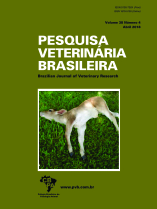 |
|
|
|
Year 2018 - Volume 38, Number 4
|

|
Intracellular reactive oxygen species production and phagocytosis of Staphylococcus aureus by milk neutrophils as tool to diagnose mastitis and identify susceptible dairy cows, 38(4):659-664
|
ABSTRACT.- Molinari P.C.C., Blagitz M.G., Della Libera A.M.M.P, Batista C.F. & Souza F.N. 2018. Intracellular reactive oxygen species production and phagocytosis of Staphylococcus aureus by milk neutrophils as tool to diagnose mastitis and identify susceptible dairy cows. [Produção intracelular de espécies reativas de oxigênio e fagocitose de Staphylococcus aureus por neutrófilos lácteos como ferramentas para o diagnóstico da mastite e identificação de vacas leiteiras susceptíveis à mastite.] Pesquisa Veterinária Brasileira 38(4):659-664. Veterinary Clinical Immunology Research Group, Departamento de Clínica Médica, Faculdade de Medicina Veterinária e Zootecnia, Universidade de São Paulo, Avenida Prof. Dr. Orlando Marques de Paiva 87, Cidade Universitária, São Paulo, SP 05508-270, Brazil. E-mail: paula.molinari@icloud.com
The immune response capacity of the mammary gland plays a major role to determine if mastitis will or not be established. Thus, we hypothesize that a better understanding of polymorphonuclear neutrophil leukocyte (PMN) function will elucidate mechanisms that will improve our knowledge of how we could avoid an inflammatory process by increasing the immune capacity of the cow, and even further, to search for a tool to diagnose mastitis or a possible way to select and identify non-susceptible animals. The present study utilized 112 quarters from 28 Holstein dairy cows that were divided into quarters milk samples with somatic cell count (SCC) <2×105 cells mL-1 (n=72) and SCC >2×105 cells mL-1 (n=40). The percentages of milk PMNs and the levels of intracellular reactive oxygen species (ROS) and the phagocytosis of Staphylococcus aureus by milk neutrophils were evaluated by flow cytometry. Our results showed a higher percentage of neutrophils in quarter milk samples with high SCC (P=0.0003), and this group also had a significantly higher percentage of neutrophils that produced ROS (P=0.008). On the other hand, the phagocytosis intensity of S. aureus by milk neutrophils was higher in quarters with low SCC (P=0.003), suggesting a better mammary gland immunity against invading pathogens. Analyzing the results of the predictive values of the measured PMN functions, they cannot be used isolated as a good diagnosis test since none of them had a satisfactory sensitivity and specificity values, which was also confirmed by the Youden index values being far from one. In conclusion, the assessment of milk bovine neutrophil functions could improve our understanding of the cellular basis of mastitis. Although, the intracellular ROS production and S. aureus phagocytosis by milk neutrophil did not have high predictive values to detect intramammary infections, our results strengthen the idea that that poor bovine mammary gland neutrophil phagocytic ability may be associated with high SCC, and might be considered to identify susceptible dairy cows to mastitis.
|
| |
|
|
| |
|
 |